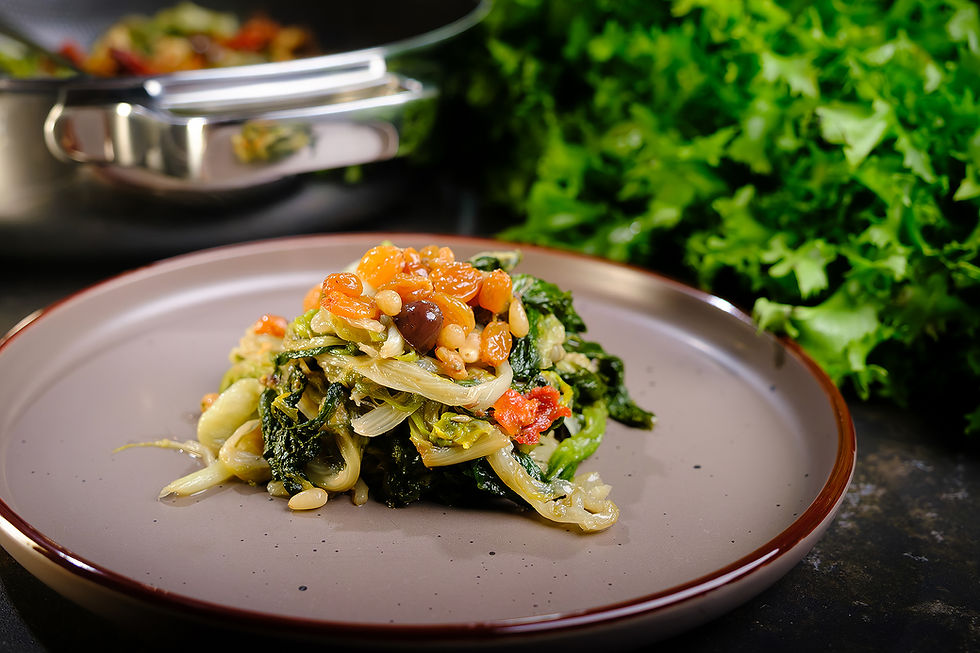Ragù alla Perugina | Umbrian Chicken & Sausage Ragù
- Pasta Grammar

- Aug 31, 2025
- 3 min read
This unique, hearty, and flavorful ragù comes from the central Italian region of Umbria, where they tend to specialize in gamier meat such as wild boar and pheasant. As some of our readers may know, Italians are loath to combine pasta with chicken… That is, unless the chicken comes in the form of giblets.

While chicken giblets aren’t the most popular meat in our modern day, they absolutely deserve more use. They’re cheap, healthy, and pack a lot of flavor (a trait which serves well when combined with ingredients such as mushrooms and sausages, as in this recipe). If you’re skeptical, this might be the recipe to bring you around!
Pairing Ragù alla Perugina with Pasta
The most common way to consume ragù is as a pasta sauce. This sauce works best with a fresh pasta, such as homemade tagliatelle (you can check out our full guide on how to easily make your own here). A traditional Umbrian choice is a pasta called “umbricelli.” Check out the video below to see how to make your own!
Watch the Pasta Grammar video:
RAGÙ ALLA PERUGINA RECIPE
Makes: 4 to 5 servings
Cook Time: 2 to 2 ½ hours
For this recipe, you will need:
Extra-virgin olive oil
4 bay leaves, divided
1.75 pounds (800 grams) chicken hearts, liver, and/or stomach
5 grams (about a large handful) dried porcini mushrooms
1 clove garlic, peeled
2 large Italian sausages
Salt
Fresh black pepper
1 cup (140 milliliters) white or red wine
28 ounces (800 grams) pure tomato puree
Grated pecorino romano cheese for topping
Add enough olive oil into a medium pot to cover the bottom. Add two bay leaves and heat over medium/high heat until the oil starts to bubble around the leaves. Add the chicken giblets and sauté until browned. Drain and remove the giblets from the pot with a slotted ladle and let them cool to the touch.
Meanwhile, soak the dried mushrooms in water for 10 to 15 minutes.
Roughly chop the sautéed giblets. Drain the mushrooms, squeeze out the excess water, and chop them. Remove and discard the sausage skin and crumble the meat.
Add enough olive oil into a large pot to cover the bottom and add the peeled garlic clove. Heat over medium/high heat until the oil starts to bubble around the garlic, then add the sausage meat and chopped mushrooms. Sauté until the meat is browned, then add the chopped giblets.
Generously season the meat with salt and black pepper, stir all together, then add the wine. Lower the heat and bring the wine to a simmer. Let simmer until the wine has cooked off and the only liquid that remains is the olive oil and meat fat.
Add the tomato puree, salt the sauce again, and bring it to a gentle simmer. Cook partially covered, stirring occasionally, for 1 to 1 ½ hours. If the sauce thickens too much before the 1 hour mark, you can always thin it with a little warm water. As the ragù nears completion, salt it again to taste, if needed.
The ragù can be used right away, stored in the fridge for several days, or frozen for longer storage. To serve with pasta, ladle the desired amount of ragù into a large pan (or keep it in the pot if using all) and warm it on the stovetop. Cook the pasta as directed and transfer the drained pasta into the ragù. Stir all together over medium/high heat until the pasta is well coated. Serve immediately, topped with grated pecorino cheese.
Buon appetito!








Wow, I don't have a link to post so I can spam your readers. So sad. I love watching you guys and the journey you have made.
hinjewadi servie ++ wakad service ++ ravet service ++ baner service ++ pimri cinchwad ++
pimple saudagar ++ balewadi service ++ bavdhan service ++ shivaji nagar ++ viman nagar ++
kharadi service ++ magarpatta service ++ koregaon park ++ kalyani nagar ++ deccan service ++
pune service ++ pashan service ++ nigdi service ++ aundh service ++ bhumkar chowk service ++
sb road service ++ best city pine ++ best hotel pune ++ pune airport service ++ vip city pune ++
real city pune + + lovely desire pune ++
The design and usability of Cricbet99 really impressed me. The Cricbet99 login page is fast and smooth, and I didn’t face any issues getting my Cricbet99 ID. The Cricbet99 app is lightweight yet powerful — great for live games. I played at the Cricbet99 live casino and loved the instant results. I’ve had a couple of good Cricbet99 win sessions, and the Cricbet99 club community feels very active.
To know more visit : https://officialcricbet99.com/
If you’re looking for a reliable and exciting platform, Fairplay is the one! The Fairplay Login takes just seconds, and the Fairplay App runs effortlessly on mobile. My Fairplay ID opens up a world of games and sports action that’s always fair and fun. I genuinely appreciate the level of transparency and thrill that defines fair play. Explore it now: https://fairpplay.com/
Transform your break into a drifting adventure with Play Drift Boss Game, where every thrilling slide becomes your ultimate escape.